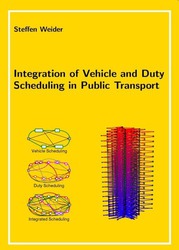| Fachbereiche | |
|---|---|
| Buchreihen (96) |
1378
|
| Nachhaltigkeit |
3
|
| Gesundheitswesen |
1
|
| Geisteswissenschaften |
2364
|
| Naturwissenschaften |
5406
|
| Mathematik | 229 |
| Informatik | 319 |
| Physik | 980 |
| Chemie | 1363 |
| Geowissenschaften | 131 |
| Humanmedizin | 243 |
| Zahn-, Mund- und Kieferheilkunde | 10 |
| Veterinärmedizin | 108 |
| Pharmazie | 147 |
| Biologie | 835 |
| Biochemie, Molekularbiologie, Gentechnologie | 121 |
| Biophysik | 25 |
| Ernährungs- und Haushaltswissenschaften | 45 |
| Land- und Agrarwissenschaften | 1004 |
| Forstwissenschaften | 201 |
| Gartenbauwissenschaft | 20 |
| Umweltforschung, Ökologie und Landespflege | 148 |
| Ingenieurwissenschaften |
1793
|
| Allgemein |
98
|
|
Leitlinien Unfallchirurgie
5. Auflage bestellen |
|
Erweiterte Suche
Integration of Vehicle and Duty Scheduling in Public Transport
Steffen Weider (Autor)Vorschau
Inhaltsverzeichnis, Datei (47 KB)
Leseprobe, Datei (140 KB)
This thesis describes the algorithm IS-OPT that integrates scheduling of vehicles and duties in public bus transit. IS-OPT is the first algorithm which solves integrated vehicle and duty scheduling problems arising in medium sized carriers such that its solutions can be used in daily operations without further adaptions.
This thesis is structured as follows: The first chapter highlights mathematical models of the planning process of public transit companies and examines their potential for integrating them with other planning steps. It also introduces descriptions of the vehicle and the duty scheduling problem. Chapter 2 motivates why it can be useful to integrate vehicle and duty scheduling, explains approaches of the literature, and gives an outline of our algorithm IS-OPT.
The following chapters go into the details of the most important techniques and methods of IS-OPT: In Chapter 3 we describe how we use Lagrangean relaxation in a column generation framework. Next, in Chapter 4, we describe a variant of the proximal bundle method (PBM) that is used to approximate linear programs occurring in the solution process. We introduce here a new variant of the PBM which is able to utilize inexact function evaluation and the use of epsilon-subgradients. We also show the convergence of this method under certain assumptions. Chapter 5 treats the generation of duties for the duty scheduling problem. This problem is modeled as a resourceconstraint-shortest-path problem with non-linear side constraints and nearly linear objective function. It is solved in a two-stage approach. At first we calculate lower bounds on the reduced costs of duties using certain nodes by a new inexact label-setting algorithm. Then we use these bounds to speed up a depth-first-search algorithm that finds feasible duties. In Chapter 6 we present the primal heuristic of IS-OPT that solves the integrated problem to integrality. We introduce a new branch-and-bound based heuristic which we call rapid branching. Rapid branching uses the proximal bundle method to compute lower bounds, it introduces a heuristic node selection scheme, and it utilizes a new branching rule that fixes sets of many variables at once. The common approach to solve the problems occurring in IS-OPT is to trade inexactness of the solutions for speed of the algorithms. This enables, as we show in Chapter 7, to solve large real world integrated problems by IS-OPT. The scheduled produced by IS-OPT save up to 5% of the vehicle and duty cost of existing schedules of regional and urban public transport companies.
| ISBN-13 (Printausgabe) | 3867274185 |
| ISBN-13 (Printausgabe) | 9783867274180 |
| ISBN-13 (E-Book) | 9783736924185 |
| Buchendformat | A5 |
| Sprache | Englisch |
| Seitenanzahl | 220 |
| Auflage | 1 |
| Band | 0 |
| Erscheinungsort | Göttingen |
| Promotionsort | Berlin |
| Erscheinungsdatum | 15.11.2007 |
| Allgemeine Einordnung | Dissertation |
| Fachbereiche |
Mathematik
|
| Schlagwörter | Öffentlicher Personennahverkehr, lineare Optimierung, Umlaufplanung, Dienstplanung, Integration. |








